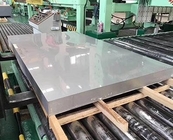-
Stainless Steel Round Pipe
-
Stainless Steel Welded Pipe
-
Stainless Steel Seamless Pipe
-
Carbon Steel Pipe
-
Galvanized Steel Pipe
-
Stainless Steel Sheet Plate
-
Angle Steel Profile
-
Stainless Steel Round Bar
-
Aluminum Alloy Sheet
-
Stainless Steel Coil
-
Galvanized Steel Sheet
-
Copper Tube Pipe
-
Copper Alloy Plate
-
Copper Strip Roll
-
Aluminum Alloy Foil
-
Tinplate
-
Other Alloy Metals
-
Rectangular Steel Pipe
1mm 2mm 316l 304 316 Stainless Steel Sheet Metal 20 Gauge 309 303 Ss Plate Manufacturers

Contact me for free samples and coupons.
Whatsapp:0086 18588475571
Wechat: 0086 18588475571
Skype: sales10@aixton.com
If you have any concern, we provide 24-hour online help.
x| Name | Stainless Steel Sheet Plate | Type | SS Tube |
|---|---|---|---|
| Length | 2000/2438/2500/3000/3048 Mm | Width | 1000/1219/1250/1500 Mm |
| Processing Service | Bending, Welding, Decoiling, Punching, Cutting | Delivery Time | 7-15 Days |
| Surface | BA/2B/NO.1/NO.3/NO.4/8K/HL/2D/1D | ||
| High Light | 1mm 316 stainless steel sheet,20 gauge 316 stainless steel sheet,304 316 stainless steel sheet |
||
316L stainless steel sheet
Type 316 Stainless Steelis an austenitic chromium nickel stainless steel containing molybdenum. This addition increases general corrosion resistance, improves resistance to pitting from chloride ion solutions, and provides increased strength at elevated temperatures.
Online consultationProject Introduction
Type 316 Stainless Steel is an austenitic chromium nickel stainless steel containing molybdenum. This addition increases general corrosion resistance, improves resistance to pitting from chloride ion solutions, and provides increased strength at elevated temperatures. Properties are similar to those of Type 304 except that this alloy is somewhat stronger at elevated temperatures.
Corrosion resistance is improved, particularly against sulfuric, hydrochloric, acetic, formic and tartaric acids; acid sulfates and alkaline chlorides. Type 316L Stainless Steelis an extra-low carbon version of Type 316 that minimizes harmful carbide precipitation in the heat affected zone during welding.
Specifications
ASTM A240, A666
Typical Applications
exhaust manifolds, furnace parts, heat exchangers, pharmaceutical and photographic equipment, valve and pump trim, chemical equipment, digesters, tanks, evaporators, pulp, paper and textile processing equipment, parts exposed to marine atmospheres and tubing
Chemical Composition: ASTM A240, A666
|
Element |
Type 316 |
Type 316L |
|
Carbon |
0.08 max. |
0.030 max. |
|
Manganese |
2.00 max. |
2.00 max. |
|
Sulfur |
0.030 max. |
0.030 max. |
|
Phosphorus |
0.045 max. |
0.045 max. |
|
Silicon |
1.0max. |
1.0max. |
|
Chromium |
16.0 18.0 |
16.0 18.0 |
|
Nickel |
10.00 14.00 |
10.00 14.00 |
|
Molybdenum |
2.00 3.00 |
2.00 3.00 |
|
Nitrogen |
0.10 max. |
0.10 max. |
Mechanical Properties: ASTM A240
|
Type |
Yield Strength 0.2% offset (KSI) |
Tensile Strength (KSI) |
% Elongation (2" Gauge length) |
Hardness Rockwell |
|
316 |
30 min. |
75 min. |
40 min. |
HRB 95 max. |
|
316L |
25 min. |
70 min. |
40 min. |
HRB 95 max. |
Physical Properties
|
Density (lb./ in^2) @ RT |
0.29 |
|
|
Modulus of Elasticity in Tension (psi x 10^6) |
28.0 |
|
|
Specific Heat (BTU/°F/lb.) |
32 to 212 °F |
0.12 |
|
Thermal Conductivity (BTU/hr/ft^2/ft) |
212°F |
9.4 |
|
932°F |
12.4 |
|
|
Mean Coefficient of Thermal Expansion (in. x 10^-6 per °F) |
32 to 212°F |
8.9 |
|
32 to 600°F |
9.0 |
|
|
32 to 1,000°F |
9.7 |
|
|
32 to 1,200°F |
10.3 |
|
|
Electrical Resistivity (micro ohms - cm) |
at 70°F |
29.4 |
|
Melting Point Range (°F) |
2500 - 2550 |
Processing
Types 316 and 316L are non-hardenable by heat treatment. Annealing: Heat to 1900 - 2100°Fthen rapidly quench Forming: Types 316 and 316L can be readily formed and drawn.
Welding
These alloys are generally considered to have poorer weldability than Types 304 and 304L. A major difference is the higher nickel content for these alloys which requires slower arc welding speed and more care to avoid hot cracking. When filler is needed, AWS E/ER 316L and 16-8-2 are most often specified.
Corrosion
Types 316 and 316L Stainless Steels exhibit better corrosion resistance than Type 304. They provide excellent pitting resistance and good resistance to most chemicals involved in the paper, textile and photographic industries.





